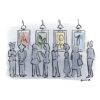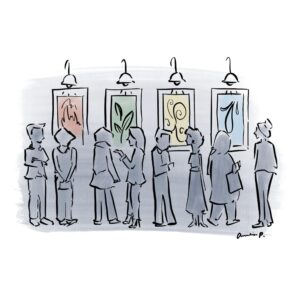The art room at Armstrong, one of D.C.’s first high schools for African American students, was “a beautiful place, just where I belonged.” So recalled a former student whose comment is placed at the opening of the Anacostia Community Museum’s “A Bold and Beautiful Vision: A Century of Black Arts Education in Washington, D.C., 1900-2000.”
This particular memory belonged to Alma Thomas, who ultimately became a major artist and one of the city’s best-known Black painters. The 1911 Armstrong graduate is the ideal person to introduce this celebratory exhibition, since she was both an artist and an arts educator who taught for decades at Shaw Junior High School.
The range of these schools and the talent they cultivated is striking. Such aspiring artists and performers as pianist Billy Taylor, sculptor and graphic artist Elizabeth Catlett, and flutist and printmaker Lloyd McNeill were nurtured by Dunbar High School, established in 1870, the nation’s first public high school for African American students. After the D.C. school system’s racial integration in 1954, Black students also attended McKinley Tech, which was originally the White equivalent to Armstrong. The Duke Ellington School of the Arts, named for an Armstrong alumnus, was established in 1974 and continues today.
Considerably more ad hoc was the storefront school called the New Thing Art and Architecture Center, whose brief but prominent existence from 1966 to 1972 was the subject of a recent American University exhibition.
At the college level, Howard University developed an influential art department, founded in 1921 as the first such unit at a historically Black college or university. Among the significant artists who taught at Howard were Loïs Mailou Jones and David C. Driskell. Miner Teachers College, later absorbed into the University of the District of Columbia, educated Alma Thomas (who also attended Howard) and poet Dolores Kendrick.
All these institutions are spotlighted in “A Bold and Beautiful Vision,” which features photographs, artworks, posters, videos and a few artifacts. On display are Thomas’s brushes and watercolor-paint blocks, as well as a piano custom-built for operatic soprano Lillian Evanti, who graduated from Armstrong a few years before Thomas and studied at both Miner and Howard.
The earliest figure in the narrative is Thomas W. Hunster, described by the show’s catalogue as the “forgotten founder of arts education in Washington.” The Ohio native stopped in D.C. in 1875 to earn some money before embarking on a planned trip to Paris. The superintendent of the city’s Black schools asked him to teach art here, and he ended up staying 50 years.
Hunster taught at Dunbar and Miner, and Thomas was among his students. Three of his paintings, all from 1915, are included in the show. They’re extremely skillful and utterly traditional landscape oils that depict wild American scenes in a European style already outdated in Europe at the time. Hunster was clearly keen on being accepted by the mainstream art world, not in challenging it.
That’s characteristic of the artworks in this show, nearly all of which are representational. The selection does include one significant modernist piece, a large wooden assemblage by Sam Gilliam, who didn’t attend D.C. schools but did work in them, teaching at McKinley from 1962 to 1967. “Daily Red” is a 1998 sculpture that furthers Gilliam’s project of expanding color-field painting to three dimensions, originally pursued with draped canvases. The sculpture’s brightly painted plywood components are punctuated by oval and circular cutouts that call attention to the way the piece occupies space — and to the open areas that remain unoccupied. The title, a play on “daily bread,” asserts that art is essential to human existence.
Aside from Gilliam’s work, the show’s most memorable pictures chronicle everyday Black life and family connections, elementary subjects yet ones often threatened by White racism. Among the elegant Catlett prints are examples of the series “The Black Woman” and her “Two Generations,” which appears to depict a grandmother and child. James A. Porter, an Armstrong graduate, depicts the nation’s first Black YMCA in a large circa-1934 painting of the 12th Street NW facility.
The show’s exemplary picture is by John N. Robinson, a D.C. native and junior high school dropout whose talents were later discovered, leading to lessons from Howard art professor James V. Herring. The painting, made circa 1980, neatly encapsulates the themes of family, art and education. Nine kids, the artist’s grandchildren, sit around a table, drawing and painting. Three hold up their artwork for Grandad’s inspection, and most are smiling. Perhaps none of the kids will grow up to be an acclaimed artist like Sam Gilliam, but they seem to share his sense that art is as fundamental as food.
If you go
A Bold and Beautiful Vision: A Century of Black Arts Education in Washington, D.C., 1900-2000
Anacostia Community Museum, 1901 Fort Pl. SE. 202-633-4820. anacostia.si.edu.
Dates: Through March 2.
Prices: Free.
This post was originally published on this site be sure to check out more of their content


